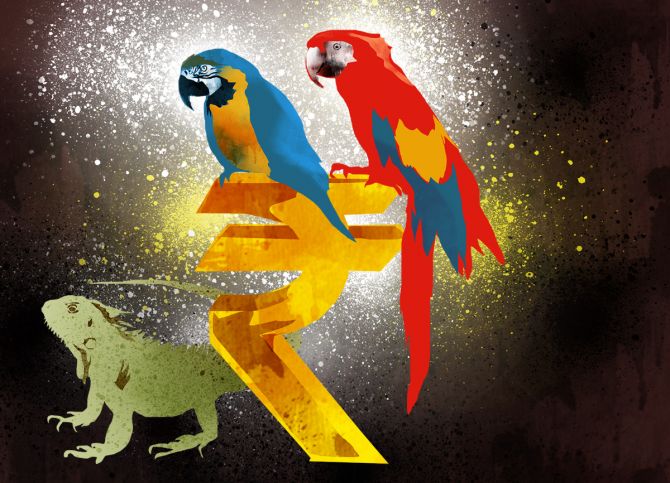The prices are no deterrent for those eager to be 'different' or seeking exotic pets as status symbols.
Akshara Srivastava, Shine Jacob & Ishita Ayan Dutt report.

White-lipped tamarin is a type of monkey that lives in the Amazon area of Brazil and Bolivia.
Prevost’s squirrel is a colourful species from the forests in the Thai-Malay Peninsula and nearby islands.
Sugar gliders are tiny marsupials — 6.3 to 8.3 inches in length — native to Australia.
In mid-May, all three were present at the Chennai international airport as customs officials thwarted attempts to smuggle in a bunch of exotic animals concealed inside bags.
A few days later, on May 24, as many as 468 exotic animals — tortoises, snakes, lizards, and wildcat — were seized in Mizoram.
All these were meant to be sold as pets in India, a few to the local zoos.
They can fetch between Rs 1,500 and Rs 150,000 apiece, depending on the species, age, size, and country of origin.
In the market for exotics, the African grey parrot sits on a perch of its own, with a price tag frequently higher than Rs 125,000, said a source.
The prices are no deterrent for those eager to be ‘different’ or seeking exotic pets as status symbols.
In a voluntary disclosure scheme for exotic live species in 2020, animal or plant, 32,645 people applied.
According to a Traffic India report titled High Flying, more than 70,000 native and exotic wild animals, including their body parts or derivatives (weighing around 4,000 kg), were seized at Indian airports between 2011 and 2020.
“The cost of an iguana can range from Rs 20,000 to Rs 50,000, depending on their size.
"Baby macaws are priced around Rs 1.5 lakh, and a cockatiel around Rs 6,000,” said an exotic pet shop owner in Chennai.
Another pet shop owner in Uttar Pradesh said he sells iguanas starting from Rs 8,000, depending on the size.
“These iguanas were earlier brought in from Florida but are now being bred in Kerala,” he added.
Apart from iguanas, the exotic pets most in demand include the red-eared slider turtle, tarantulas, ball pythons, macaws, and the African grey parrot.
“Exotic animals, particularly non-native species, attract the attention of ‘collectors’ who consider them objects.
"The situation is complicated by the status symbol associated with ‘owning’ exotic pets,” said Rajlakshmi Kanjilal, who specialises in animal studies.
A pet shop owner in Kolkata said he gets requests for exotic species such as Rosella, Conures, Persian cats and dogs once every month or two.
Normally, they are priced at Rs 10,000 and above.
Since 1976, India has been a member of the Convention on International Trade in Endangered Species of Wild Fauna and Flora (Cites), an international agreement between governments that aims to ensure international trade in specimens of wild animals and plants does not threaten their survival.
“But, while animals under Cites will get some protection by way of licences, there is no law governing their trade once these animals are inside the Indian limits,” said Jose Louies, who heads the wildlife crime control division at the Wildlife Trust of India.
India is not merely a destination for exotic species, it is also a source for such trade.
“Some Indian species are smuggled out.
"These are turtle species for live pets, animal products like pangolin scales, tiger skin and body parts, elephant ivory, and tokay geckos.
"Snake venom comes into India and goes out,” said Agni Mitra, Regional Deputy Director, Wildlife Crime Control Bureau-Eastern Region.
The Indian hill mynah is one of the most sought-after pets as it mimics human sounds.
“The Wildlife (Protection) Act, 1972, only prohibits trading in native species.
"Non-native animals pose a loophole, as they are not covered under the law,” said Kartick Satyanarayan, co-founder and CEO of Wildlife SOS.
Conservationists hope Parliament will pass the wildlife (protection) amendment bill, 2021 this year, helping increase the purview of the law.











